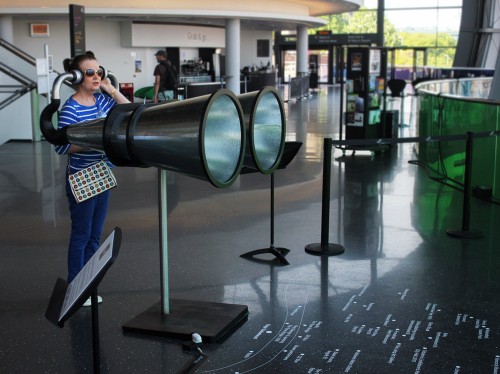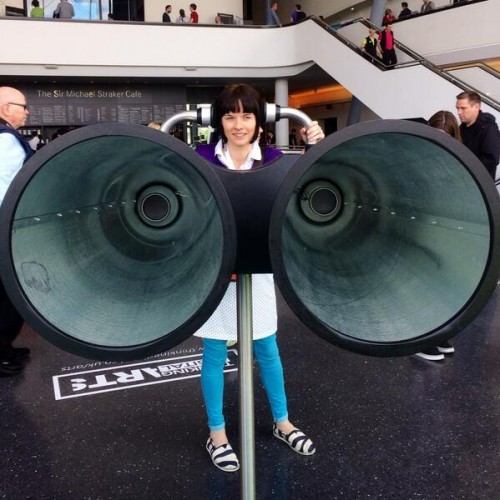| When faced with the possibility of birds disguised as robots in disguise, being told by Rovio that Angry Birds Transformers is coming soon –isn’t fast enough! While some people may wonder just how many variations on Angry Birds is too many, but those of us addicted to the franchise look forward to each and every one. Aside from featuring Autobirds and Deceptihogs, details of just how the game will work aren’t yet known. Fellow children of the 80′s (if you will indulge me as I pretend it’s not the 70′s for me) will appreciate the familiarity of the Transformers characters (and cool-factor) no matter what the price-tag for the game ends up being, but Rovio has established a relatively new pattern of offering the title for free while making their fortune from in-app purchases for extra levels or other bonuses. Angry Birds Transformers Out Soon is a post from: Good e-Reader |
A Semi-automated Technology Roundup Provided by Linebaugh Public Library IT Staff | techblog.linebaugh.org
Monday, June 16, 2014
Angry Birds Transformers Out Soon
Onyx Boox Lynx e-Reader Review
|
The Onyx Boox Lynx is part of a new breed of open Android e-readers that allow you to install your own apps and not lock you into any one specific ecosystem. Google Play is showcased on this device, and taps into an extensive wellspring of eBook reading and comic book apps. How does this e-reader compare against the Kobo Aura or the Kindle Paperwhite 2? Today, we take an extensive look. Hardware
The Lynx e-reader is very much akin to the Kobo Aura HD, in terms of specs. It features a 6.8 e-Ink capacitive Ultra HD EPD display screen and a resolution of 1440×1080 pixels. Underneath the hood is a Freescale i.MX Cortex A9 1.0GHz processor and 512MB of RAM. Books are stored on the device and has 4GB of internal storage with the option to increase it via the Micro SD Card up to 64GB. This e-reader has a front-lit display that gives the Kobo Aura and Kindle Paperwhite 2 a run for their money. Most e-readers that allow you to read in the dark end up having a blue hue that detracts away from reading. Instead, this is a brilliant white, even at full brightness. I was honestly hoping for a capacitive touchscreen display, similar to the Tolino Vision or the Kobo Aura. Instead, it is akin to the Paperwhite line of e-readers with a sunken screen and raised edges. There are manual page turn keys on the left and right side, appealing towards users who are lefties or righties. There is a simple button on the center of the screen that many people will confuse with HOME. Every single device I have ever used that had a button on the bottom functioned as the home key, instead Onyx has made it the glowlight setting. You can hold it down for 2 seconds and it will turn the front-light on or off. One of the more compelling features of the Lynx is the inclusion of a 3.55 mm headphone jack. E-Readers in the last four years have all done away with audio, in a bid to offer the hardware has cheap as they can and see audio capabilities as a way to cut costs. Onyx has a text to speech engine that allows the books to be read aloud. It also sets the stage of being able to download the Overdrive Media Console app and listen to audiobooks from your local library. Additionally, there are thousands of music apps such as Beats, Spotify or Pandora that are fully compatible. Software
The Onyx Lynx is running Google Android 4.04 and has the Google Play store loaded on it. The open Android concept is a really new thing in the world of e-readers and really hasn’t been done before. In the past, all e-readers either ran on Linux or took the Sony/Nook route and just used Android as a framework and skinned their own UI on-top of it. Onyx does have a customized Android UI as well, but they don’t let that get in the way of the traditional settings menu or the ability to sideload in your own apps or get them directly from Google Play. The Settings menu is really simplified, although the more traditional Android menu is accessible when you try and install an app from an Unknown Source and need to enable that feature. So by default, you can customize your WIFI network, access a Bluetooth device or change the refresh rate. There is even a setting to ping the Onyx servers to see if a firmware update is available. You can think of this has a fairly basic e-reader that is 100% reliant on the software you can load on it. Keep in mind, this is an e-Ink reader. You certainly won’t be able to play Angry Birds or any type of complex game. The e-paper refresh rate is is simply not indicative to do something dynamic. You should stick with reading, comic, RSS, news apps or things that are more static in nature. E-Reading
The Onyx Boox Lynx has a default reading app that will scan your Micro SD card or any books you download from 3rd party apps. I really like the default reading app, it is responsive and snappy. The Lynx may have good hardware, but it suffers a bit when it comes to installing your favorite comic, communication, or e-reading app. Most are optimized for tablets and have lots of animations and slick enhancements that make it stand out. Sadly, on the Lynx most apps are simply unusable due to long loading times and the e-Ink refresh rate. Kindle, Kobo, Marvel Comics, Nook, and WattPad are examples of mainstream apps that become too unwieldy to use effectively. WattPad and Marvel take at least four seconds to turn a page and fall victim to frame by frame refreshing. Most of the other reading apps all have their own idiosyncrasies. Take the Kindle app for example, turning pages has animations that make the next page slide in and no way to disable it. Some of these issues are solved by changing the refresh rate on the Lynx. Not all reading apps are incompatible with the Onyx Lynx. Aldiko, Moon+, FBReader and many others all work fine. In order to get the ideal experience you have to shut off most animations, and this warrants visiting the settings menu in each app. I have found that 3rd party apps are incompatible with the left and right manual page turn keys. In some cases clicking on it will bring up the in-app settings menu and sometimes does nothing. This is mainly due to the nature of the Android apps. They were all designed with a touchscreen in mind, so you will have to use it to turn pages. The stock reading app on the Onyx Lynx is amazing and provides a rich experience. There are over 60 different fonts available to change the entire book to something more suitable. If you can’t find something from the default list that catches your fancy, you can simply load in your own. Increasing the size of the fonts happen in real time and is very responsive, no waiting involved. You can also adjust the margins or employ the Text to Speech engine with a set of headphones. Whenever you load books on an SD card or import them in with a 3rd party reading app they will be added to your library. This is where the majority of your books are stored and has some cool sorting options. There is the ability to display cover art, grid format, delete books altogether and scan for meta data. The scanning feature is particularly useful because you can access the SD card or the devices memory for books you have downloaded from the internet or loaded in yourself. In the end, this is a great e-reader if you are using the stock app. You can fire up, import all of your books and get reading right away. The challenge is to find compatible apps that have settings to allow you to turn off animations and enhancements that were designed for smartphones and tablets. The good thing is, Google Play is a wellspring of apps and you can engage in some trial and error. Wrap Up
I am really feeling what Onyx is doing with its new lineup of e-readers in 2014. The market in North America and the UK is dominated by only a handful of players, Amazon, B&N and Kobo. The European, Russian and emerging markets are all wide open. Onyx does most of its business in Eastern Europe and Russia. They do have an established base of customers all over the world though, that often like their high build quality and like the fact they aren’t locked into any one particular ecosystem. This device has a really solid front-light, 1 GHZ processor and high resolution. The glowlight is one of the best in the business and really puts Amazon and Kobo on notice to try and refine their technology when their new products hit the market later on in the year. I would really recommend this e-reader to anyone that doesn’t want to be locked into any of the mainstream retailers. The open nature of Android on the Lynx basically allows you to install any app you want from Google Play, or alternative markets such as Good e-Reader. The freedom to pick and choose, the freedom to install anything you want or to delete it, is really compelling. PROS Excellent Front-Light CONS Pageturn keys don’t work in 3rd party apps Rating: 7.5/10 Onyx Boox Lynx e-Reader Review is a post from: Good e-Reader |
Podcast: Hachette Needs Amazon and eBook Subscription Services in Developing Countries
|
Welcome back to the Monday edition of the Good e-Reader Radio Show! Today, Michael Kozlowski and Jeremy Greenfield of DBW talk about Hachettes reliance on Amazon and how financially dependant they are for book sales in the US and UK. In addition, Amazon has been making great strides in adopting key audiobook technology from their Kindle Fire line of tablets and incorporating it into the Kindle app for iOS and Android. Is there a future in a standalone Audible app now? Finally, they two lads talk about eBook subscription services and what roles they can play in emerging markets. A great show as always, so check it out. Podcast: Hachette Needs Amazon and eBook Subscription Services in Developing Countries is a post from: Good e-Reader |
URL: http://goodereader.com/blog/e-reader-radio/podcast-hachette-needs-amazon-and-ebook-subscription-services-in-developing-countries?utm_source=rss&utm_medium=rss&utm_campaign=podcast-hachette-needs-amazon-and-ebook-subscription-services-in-developing-countries
Enclosure: http://goodereader.com/blog/podpress_trac/feed/79219/1/goodereader-radio-june16-2014-final.mp3
Find funding with sponsored collections
| The popularity of your digital library is growing, and with that excitement comes the challenge of keeping up with demand. How do you make sure you have enough copies of the popular titles while stretching your budget to buy all the newest releases? One way is to find new sources of funding, which can include donations from local businesses, organizations, and community members. OverDrive can then help you recognize donors for their contribution on your digital library website in the form of a collection name, digital title plate, or a website ad that rotates throughout the site. Many libraries are already tapping into this idea. Wake County Public Libraries has a sponsored collection donated by their generous members, which they recognize here and on the title detail page of each book. The Municipal Library Consortium of St. Louis County recognized the donor of each title on the detail page as shown here. Collection name example:  You can have collections separated by the donated party, or gathered together in a single collection. Digital title plate example: 
A website ad example: 
If you're looking for new ways to help grow your digital collection and meet patron demand, sponsorships are a great way to generate new sources of funding and involve your community. Contact your Account Specialist with any questions, or to get started! |
URL: http://feedproxy.google.com/~r/DigitalDistributionBlogOverdrive/~3/2_I-NDs9oLw/
Library, ALA Under Fire for Inappropriate Computer User
|
Exciting new libraries have sprung up, though, some of which are digital nirvanas. With comments that some look more like an Apple Store showroom than a public library, interesting new lending models and digital access have become the hallmark for library relevance. But one library system is currently under fire for its technology practices, and the American Library Association is being blamed for supporting the alleged criminal madness taking place. The Orland Park Public Library in an upscale suburb of Chicago has been at the center of legal battles and controversy over the terms of their computer lab, namely, the lack of internet filter on the computers and the resulting swarms of registered sex offenders who use them. According to the watchdog group Illinois Leaks, the ongoing problem stems from the library’s refusal to block pornography sites, including sites that feature child pornography. As a result, there have been numerous reports of users literally sitting at the computers and masturbating to the images they’re accessing, as well as reports that women and children in the library have been accosted. In addition, reports have been made that some of the individuals accessing these sites on the library’s computers are in violation of the terms of their parole, and that they come to the library because their home internet use is being monitored. While some 22 reports have been made already, the group states that none of the reports were shared with the police, a direct violation of the library board’s own policy. For its part, the library cites ALA guidelines and support that access to information should not be limited by public libraries, supposedly even going so far as to state that child pornography qualifies as “information” and therefore should be accessible given that libraries are funded by tax dollars and are therefore the property of the community. The Supreme Court ruled in 2003 (US v ALA), however, that this level of access does not extend to criminal activities. The waters are further muddied in this case by ongoing fighting between the library board and local community members who want something done about both the computer use and the physical behavior that these critics say is directly tied to that computer use. Illinois Leaks has stated that the board has blocked attempts to secure documents under the Freedom of Information Act, that it has barred individuals from speaking during the public comments’ portion of meetings, that it conducts illegal closed meetings on state and federal holidays, and more. New information on further obstacles was posted today.
Library, ALA Under Fire for Inappropriate Computer User is a post from: Good e-Reader |
GoFly Turns Kobo Mini into Tactical Glide Computer for XC Pilots (Video)
| A necropost over at MobileRead led me to an interesting project that I hadn’t seen before involving a Kobo Mini and some major hacking. Over at |
URL: http://feeds.the-ebook-reader.com/~r/feedburner/cmWU/~3/C-fNNfk6JLw/
Art Showcase: Binaudios
| Hey all – Rachel here! I have spent the last year talking with lots of artists who are making amazing things with Raspberry Pis. Every day my inbox is PINGing with exciting progress news. So I’m going to start showcasing some of these projects on the blog. I find them incredibly inspiring – I hope you do too! I’m going to kick off with a piece from one of my favourite artists: Dominic Wilcox. I bet you’ve seen some of his work kicking around the internet – He made the GPS shoes which guided you home and did some narrative sculptures inside watch faces.
This time he’s partnered up with Creative Technologist James Rutherford to produce Binaudios; a device that enables the user to listen to the sounds of the city – at the moment it’s installed in the Sage Gateshead music discovery centre.
I’ve met loads of 'Creative Technologists' on my travels. They believe creativity and art are the driving forces behind the technology they make. James describes his work as “somewhere between code and art”. He mainly creates software; developing visualisations, data tools or games.
Binaudios was his first Raspberry Pi project AND first go with Python! Just for you guys, he has very kindly written up how Binaudio is put together:
You can see them in action in this video or you can go and visit in person! Binaudios was commissioned by the awesome Suzy O’Hara at Thinking Digital Arts. |
UK Groups, Authors Rally to Support Reading in Prisons
|
In the US, one recent police sting operation brought down more than thirty members of a religious organization who were sneaking drugs into one facility by enclosing them inside the tiny laminated tabs that denote the different books of the Bible. The inmates received the Bibles and pried open the tabs, then ingested or sold the drugs to other inmates. But literacy advocates, prisoners’ rights groups, and even authors have weighed in on the blanket mandate that prevents prisoners from receiving books from friends or family members; organizations have also been blocked from distributing reading material to prisons. A discussion forum for the June 13th Reading in Prison day, an effort led by Prison Reading Groups in partnership with the University of Roehampton and the Prisoners' Education Trust, brought together interested parties and stakeholders to determine what benefits there are to making reading material available to incarcerated people. Attendees heard from the heads of several organizations on the benefits of book access, as well as from prisoners who were able to outline what exactly it means to be able to read while incarcerated. It’s hopefully not true that this mandate stems from lawmakers who aren’t fully invested in finding a solution. A number of companies already offer e-readers that would work well in correctional facilities, including some that cannot be used to access the internet or for communication outside of the facility. Findaway World even offers ones that come preinstalled with locked content that cannot be deleted or altered. eBooks lend themselves perfectly to this situation, and are a cost-effective, manageable solution should government leaders wish to actually resolve the issue.
UK Groups, Authors Rally to Support Reading in Prisons is a post from: Good e-Reader |
Amazon’s Top 100 Rated Tablets Includes 98 iPads
| Yesterday I was looking over Amazon’s best sellers list for the top 100 tablets when I made an interesting observation. In addition to the best sellers list, Amazon has top 100 lists for hot new releases, most wished for, gift ideas, and top rated. Amazon’s own Kindle Fire tablets top the lists for best sellers, […] |
URL: http://feeds.the-ebook-reader.com/~r/feedburner/cmWU/~3/sQPLwX_PJlA/
eBook Publisher Ups Author Royalty to 80%, Offers Sales Transparency
|
Any publisher–whether he’s from a major publishing house or a room-over-the-garage author who publishes his own writing–can tell you that the most significant expenses involved in creating a book are not in which format to use. While paper, ink, production, and shipping do incur an investment, the far more expensive aspects are in creating the story itself. Editing, proofreading, and the eventual marketing of the reading matter (again, regardless of how consumers choose to buy the content) mean that the costs that have to be recovered through sales. One digital publisher is working to bring that truth to the public’s understanding, largely through a transparency effort of how the book sales are broken down. 0s & 1s, which has won over a number of small press publishers to distribute their digital titles through the company, clearly demonstrates that 80% of purchase price of its books, most of which are priced in the neighborhood of six dollars, goes directly to the author. While that price point may seem a little high for an unknown author–many self-published authors keep their sales at $4.99 or less, with $2.99 being a fairly standard ebook price for indie works–given the argument that the cost of the book is in its initial creation, it makes sense. However, the company still faces a major obstacles in book discovery. While still compatible with all file formats, including Kindle’s MOBI file, the royalty rate is so high because the titles are sold through the company’s own website instead of through powerhouse book retailers. That’s great, if the company can establish a loyal customer base, something that even major publishing houses have not been able to do. Until large-scale efforts to entice reading consumers away from Amazon are effective, authors who make higher royalties on higher book prices still may not sell the volume they wish to sell.
eBook Publisher Ups Author Royalty to 80%, Offers Sales Transparency is a post from: Good e-Reader |
Onyx Boox T68 eBook Reader Video Review
| Earlier in the month, the Onyx Boox T68 turned up in a short video review from an Italian ereader website. Now we’ve got a more detailed look at the T68 in action from a German ebook reader blog. The Onyx Boox T68 is one of the most intriguing E Ink ereaders that is going to […] |
URL: http://feeds.the-ebook-reader.com/~r/feedburner/cmWU/~3/Niw4t9Bx29A/
Does Microsoft Have Any Claim On Android?
|
As Microsoft joined the litigation fray, we saw a few of their allegations seep out –but it now appears they feel Android violates 127 different patents (such as 8,255,379 “Customer Local Search”, 5,813,013 “Representing Recurring Events”, and 6,999,047 “Locating and Tracking a User in a Wireless Network Through Environmentally Profiled Data”). Of course, it’s not straightforward: many of the patents Microsoft lays claim to come from a package of intellectual property purchased in a $4.5-billion group bid for assets sold when Nortel collapsed (which means they are jointly owned with the others involved in the sale, including: Apple, Microsoft, Blackberry, Ericsson, and Sony). Some were passed to individual companies from the consortium, but it’s all incredibly confusing and complicated. Is Microsoft owed money from Android? Maybe, that will be up to the courts to inevitably decide. Are we all terribly sick of patent-related law suits? Without question. Does Microsoft Have Any Claim On Android? is a post from: Good e-Reader |














